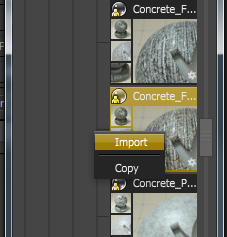
The 3DS Max® plugin has access to the OctaneRender® online Live DB, which is OctaneRender’s asset database. It stores MaterialsA set of attributes or parameters that describe surface characteristics., groups of Nodes, and whole scenes shared by the OctaneRender community and the OctaneRender team. The asset database makes it easier to move groups of Nodes, scenes, and assets across the OctaneRender plugins and the Standalone edition.
You can access the Live DB from the Octane menu (Figure 1), or by opening the Render Setup window, then clicking on the Tools tab and clicking on the Open LiveDB button (Figure 2).

Figure 1: Accessing the Octane Live DB from the Octane menu

Figure 2: Live DB
Many of the Materials contain Texture maps. 3ds Max cannot store these texture maps within a scene, so 3ds Max saves the texture maps to disk under a specified folder and adds the material name to the path. You can customize the path in Imported TexturesTextures are used to add details to a surface. Textures can be procedural or imported raster files. Path directory.
To use a material in the Live DB, right-click on the MaterialThe representation of the surface or volume properties of an object. thumbnail and click Import.

Figure 3: Importing a Material
LocalDB Directory - Select the LocalDB directory. This should match the directory set in OctaneRender Standalone Preferences. See options to move files in Octane Preferences > Material tab.
Imported Textures Path - Defines the folder to save the textures from LiveDB.
Open LiveDB - Open the LiveDB tool.
Refresh LiveDB - Manual refresh the content of the LiveDB tool.
Explore LocalDB - Open Windows Explorer to the LocalDB folder.
Explore Textures - Opens Windows Explorer to the Imported Textures folder.